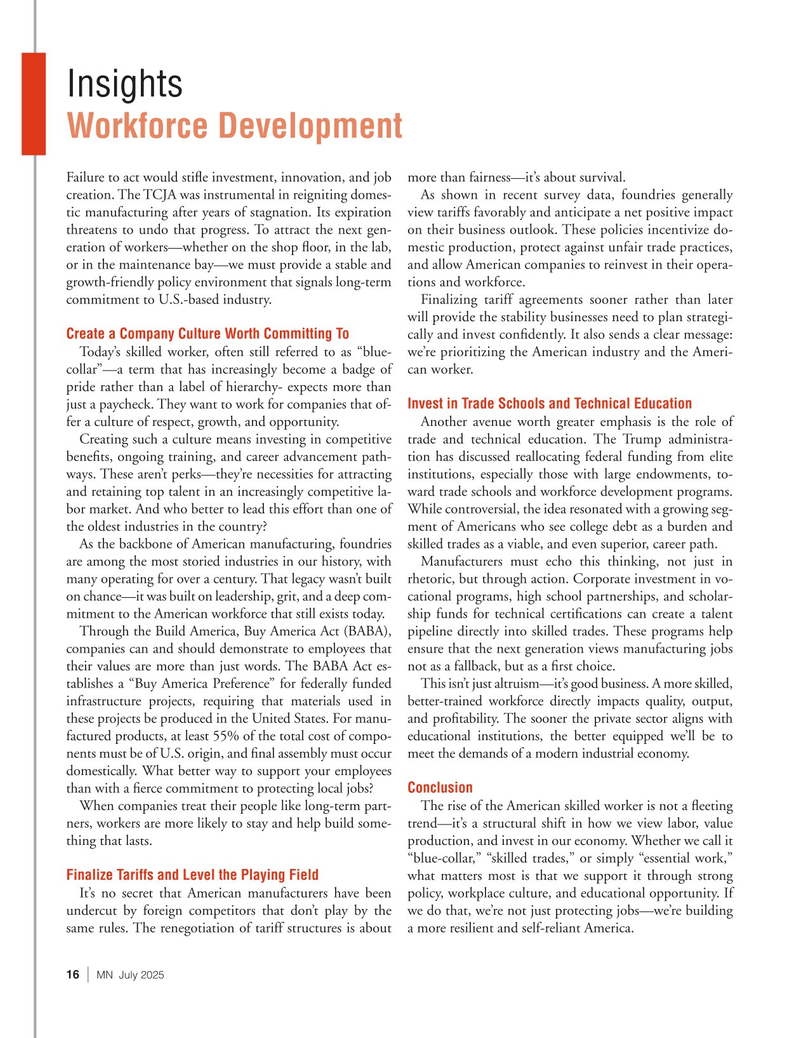
Page 16: of Marine News Magazine (July 2025)
Read this page in Pdf, Flash or Html5 edition of July 2025 Marine News Magazine
Insights
Workforce Development
Failure to act would sti? e investment, innovation, and job more than fairness—it’s about survival.
creation. The TCJA was instrumental in reigniting domes- As shown in recent survey data, foundries generally tic manufacturing after years of stagnation. Its expiration view tariffs favorably and anticipate a net positive impact threatens to undo that progress. To attract the next gen- on their business outlook. These policies incentivize do- eration of workers—whether on the shop ? oor, in the lab, mestic production, protect against unfair trade practices, or in the maintenance bay—we must provide a stable and and allow American companies to reinvest in their opera- growth-friendly policy environment that signals long-term tions and workforce.
commitment to U.S.-based industry. Finalizing tariff agreements sooner rather than later will provide the stability businesses need to plan strategi-
Create a Company Culture Worth Committing To cally and invest con? dently. It also sends a clear message:
Today’s skilled worker, often still referred to as “blue- we’re prioritizing the American industry and the Ameri- collar”—a term that has increasingly become a badge of can worker.
pride rather than a label of hierarchy- expects more than just a paycheck. They want to work for companies that of- Invest in Trade Schools and Technical Education fer a culture of respect, growth, and opportunity. Another avenue worth greater emphasis is the role of
Creating such a culture means investing in competitive trade and technical education. The Trump administra- bene? ts, ongoing training, and career advancement path- tion has discussed reallocating federal funding from elite ways. These aren’t perks—they’re necessities for attracting institutions, especially those with large endowments, to- and retaining top talent in an increasingly competitive la- ward trade schools and workforce development programs. bor market. And who better to lead this effort than one of While controversial, the idea resonated with a growing seg- the oldest industries in the country? ment of Americans who see college debt as a burden and
As the backbone of American manufacturing, foundries skilled trades as a viable, and even superior, career path.
are among the most storied industries in our history, with Manufacturers must echo this thinking, not just in many operating for over a century. That legacy wasn’t built rhetoric, but through action. Corporate investment in vo- on chance—it was built on leadership, grit, and a deep com- cational programs, high school partnerships, and scholar- mitment to the American workforce that still exists today. ship funds for technical certi? cations can create a talent
Through the Build America, Buy America Act (BABA), pipeline directly into skilled trades. These programs help companies can and should demonstrate to employees that ensure that the next generation views manufacturing jobs their values are more than just words. The BABA Act es- not as a fallback, but as a ? rst choice.
tablishes a “Buy America Preference” for federally funded This isn’t just altruism—it’s good business. A more skilled, infrastructure projects, requiring that materials used in better-trained workforce directly impacts quality, output, these projects be produced in the United States. For manu- and pro? tability. The sooner the private sector aligns with factured products, at least 55% of the total cost of compo- educational institutions, the better equipped we’ll be to nents must be of U.S. origin, and ? nal assembly must occur meet the demands of a modern industrial economy.
domestically. What better way to support your employees than with a ? erce commitment to protecting local jobs? Conclusion
When companies treat their people like long-term part- The rise of the American skilled worker is not a ? eeting ners, workers are more likely to stay and help build some- trend—it’s a structural shift in how we view labor, value thing that lasts. production, and invest in our economy. Whether we call it “blue-collar,” “skilled trades,” or simply “essential work,”
Finalize Tariffs and Level the Playing Field what matters most is that we support it through strong
It’s no secret that American manufacturers have been policy, workplace culture, and educational opportunity. If undercut by foreign competitors that don’t play by the we do that, we’re not just protecting jobs—we’re building same rules. The renegotiation of tariff structures is about a more resilient and self-reliant America.
16 | MN July 2025

 15
15

 17
17
